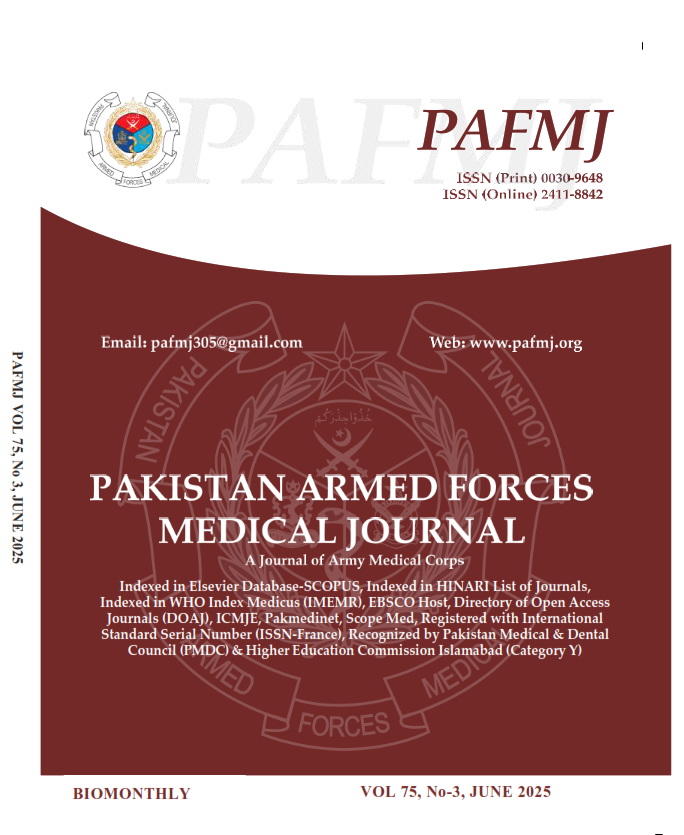Comparison of Clinical Efficacy of Topical Cyclosporine A 0.05% With Loteprednol 0.5% In The Treatment of Chronic Blepharitis
DOI:
https://doi.org/10.51253/pafmj.v75i3.6036Keywords:
Blepharitis, Clinical Efficacy, Cyclosporine, LoteprednolAbstract
Objective: To compare efficacy of topical Cyclosporine A 0.05% and Loteprednol 0.5% in treatment of Chronic Blepharitis.
Study Design: Quasi-Experimental study
Place and Duration of Study: Department of Ophthalmology Combined Military Hospital Quetta, Pakistan from Jul to Dec 2020.
Methodology: Thirty two patients with chronic blepharitis, Tear Film Breakup time of less than 10 seconds and Ocular Surface Disease Index Score of more than 22 in both eyes were included. Patients were randomly assigned in a 1:1 ratio to receive either topical Cyclosporine A 0.05% eye drops (Group-A) or topical Loteprednol 0.5% (Group-B) twice daily. In addition to this warm compresses, lid hygiene, topical artificial tears and antibiotic ointment were given. Follow-up appointments were scheduled at baseline, 4 weeks, 8 weeks, and 12 weeks to monitor patient progress. Data was analyzed using SPSS.
Results: A total of thirty two patients (64 eyes) were enrolled in the study, with 26 patients (52 eyes) completing the full study period. OSDI scores improved over time in both groups, indicating disease resolution. However, significant improvements were observed in Group-A compared to Group-B at 3 months in OSDI scores (10.79±1.25 vs 18.23±0.65, p<0.05), TBUT (9.86±0.71 vs 8.77±0.65, p<0.05), MGSS (0.43±0.50 vs 0.81±0.63, p=0.02), LMTS (0.11±0.32 vs 0.83±0.47, p=0.05) and LSCS (0.18±0.39 vs 0.67±0.56, p=0.05). These findings suggest that Cyclosporine (Group-A) was more effective than Loteprednol (Group-B) in improving ocular surface parameters and reducing symptoms at 3 months.
Conclusion: This study demonstrates that both Cyclosporine and Loteprednol are effective in alleviating signs and symptoms of chronic
Downloads
References
Mathers WD, Shields WJ, Sachdev MS, Petroll WM, Jester JV. Meibomian gland dysfunction in chronic blepharitis. Cornea 1991; 10(4): 277-285.
https://doi.org/10.1097/00003226-199107000-00001
Lemp MA, Nichols KK. Blepharitis in the United States 2009: a survey-based perspective on prevalence and treatment. Ocular Surf 2009; 7(2): S1-S14.
https://doi.org/10.1016/s1542-0124(12)70620-1
Sandra Johanna GP, Antonio LA, Andrés GS. Correlation between type 2 diabetes, dry eye and Meibomian glands dysfunction. J Optom 2019; 12(4): 256-262.
https://doi.org/10.1016/j.optom.2019.02.003
Putnam CM. Diagnosis and management of blepharitis: an optometrist's perspective. Clin Optom 2016; 8: 71-78.
Fromstein SR, Harthan JS, Patel J, Opitz DL.Demodex blepharitis: clinical perspectives. Clin Optom 2018; 10: 57-63
https://doi.org/10.2147/opto.s142708
Doan S, Zagórski Z, Palmares J, Yağmur M, Kaercher T, Benítez-Del-Castillo JM,et al. Eyelid Disorders in Ophthalmology Practice: Results from a Large International Epidemiological Study in Eleven Countries. Ophthalmol Ther 2020; 9(3): 597-608.
https://doi.org/10.1007/s40123-020-00268-4
Rim TH, Kang MJ, Choi M, Seo KY, Kim SS. Ten-year incidence and prevalence of clinically diagnosed blepharitis in South Korea: a nationwide population-based cohort study. Clin Exp Ophthalmol 2017 ; 45(5): 448-454.
https://doi.org/10.1111/ceo.12929
Schaumberg DA, Nichols JJ, Papas EB, Tong L, Uchino M, Nichols KK. The international workshop on meibomian gland dysfunction: report of the subcommittee on the epidemiology of, and associated risk factors for, MGD. Invest Ophthalmol Vis Sci 2011; 52(4): 1994-2005.https://doi.org/10.1167/iovs.10-6997e
Amescua G, Akpek EK, Farid M, Garcia-Ferrer FJ, Lin A, Rhee MK, et al ; American Academy of Ophthalmology Preferred Practice Pattern Cornea and External Disease Panel. Blepharitis Preferred Practice Pattern®. Ophthalmology 2019; 126(1): P56-P93.
https://doi.org/10.1016/j.ophtha.2018.10.019
Comstock TL, Sheppard JD. Loteprednol etabonate for inflammatory conditions of the anterior segment of the eye: twenty years of clinical experience with a retrometabolically designed corticosteroid. Expert Opin Pharmacother 2018; 19(4): 337-353.
https://doi.org/10.1080/14656566.2018.1439920
Moon I, Kang HG, Yeo A, Noh H, Kim HC, Song JS, et al. Comparison of Ocular Surface Mucin Expression After Topical Ophthalmic Drug Administration in Dry Eye-Induced Mouse Model. J Ocul Pharmacol Ther 2018; 34(9): 612-620.
https://doi.org/10.1089/jop.2018.0005
Periman LM, Mah FS, Karpecki PM. A Review of the Mechanism of Action of Cyclosporine A: The Role of Cyclosporine A in Dry Eye Disease and Recent Formulation Developments.Clin Ophthalmol 2020; 14: 4187-4200.
https://doi.org/10.2147/opth.s279051
Schiffman RM, Christianson MD, Jacobsen G, Hirsch JD, Reis BL. Reliability and validity of the Ocular Surface Disease Index. Arch Ophthalmol 2000; 118(5): 615-621.
https://doi.org/10.1001/archopht.118.5.615
Lu F, Tao A, Hu Y, Tao W, Lu P. Evaluation of Reliability and Validity of Three Common Dry Eye Questionnaires in Chinese. J Ophthalmol 2018; 2018: 2401213.
https://doi.org/10.1155/2018/2401213
Kanski JJ, Bowling B. Clinical Ophthalmology: A Systemic Approach (Ninth Edition). New York: Elsevier Saunders; 2020, 159-160
Turgut B, Çatak O, Demir T. Meibomian gland dysfunction: an overlooked eyelid disease. Adv Ophthalmol Vis Sys 2018; 8(3): 168-172.
Chhadva P, Goldhardt R, Galor A. Meibomian gland disease: the role of gland dysfunction in dry eye disease. Ophthalmol 2017; 124(11): S20-06.
https://doi.org/10.1016/j.ophtha.2017.05.031
Baudouin C, Messmer EM, Aragona P, Geerling G, Akova YA, Benítez-del-Castillo J et al. Revisiting the vicious circle of dry eye disease: a focus on the pathophysiology of meibomian gland dysfunction. Br J Ophthalmol 2016; 100(3): 300-306.
https://doi.org/10.1136/bjophthalmol-2015-307415
Opitz DL, Harthan JS, Fromstein SR, Hauswirth S. Diagnosis and management of meibomian gland dysfunction: optome-trists’ perspective. Clini Optometry 2015; 7(1): 59–69.
Thode AR, Latkany RA. Current and emerging therapeutic strategies for the treatment of meibomian gland dysfunction (MGD). Drugs 2015; 75(11): 1177-1185.https://doi.org/10.1007/s40265-015-0432-8
Rubin M, Rao SN. Efficacy of topical cyclosporine 0.05% in the treatment of posterior blepharitis. J Ocul Pharmacol Ther 2006; 22(1): 47-53.
https://doi.org/10.1089/jop.2006.22.47
Kim HY, Lee JE, Oh HN, Song JW, Han SY, Lee JS. Clinical efficacy of combined topical 0.05% Cyclosporine A and 0.1% sodium hyaluronate in the dry eyes with meibomian gland dysfunction. Intl J Ophthalmol 2018; 11(4): 593-596.https://doi.org/10.18240/ijo.2018.04.09
Ames P, Galor A. Cyclosporin ophthalmic emulsions for the treatment of dry eye: a review of the clinical evidence. Clin Investig 2015; 5(3): 267-285.https://doi.org/10.4155/cli.14.135
Othman TM, Mousa A, Gikandi PW, AbdelMabod M, Abdelrahman AM. Efficacy and safety of using topical Cyclosporine A for treatment of moderate to severe dry eye disease. Saudi J Ophthalmol 2018; 32(3): 217-221.
Downloads
Published
Issue
Section
License
Copyright (c) 2025 Sarah Naveed Malik, Hannan Masud

This work is licensed under a Creative Commons Attribution-NonCommercial 4.0 International License.















